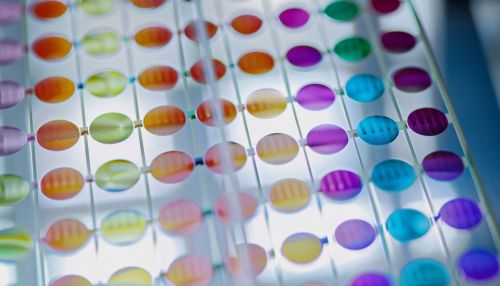DNA Microarray
Introduction
DNA microarrays, also known as biochips or gene chips, are a type of biotechnology that allows for the simultaneous analysis of thousands of gene expressions. This technology is a crucial tool in the field of molecular biology, enabling researchers to gain a comprehensive understanding of gene function and regulation.
History
The concept of DNA microarrays was first introduced in the mid-1990s. Researchers at Stanford University, including Patrick Brown and Michael Eisen, were among the pioneers in the development and application of this technology. Their work revolutionized the field of genomics, enabling high-throughput analysis of gene expression.
Principle
The principle of DNA microarrays involves the hybridization of DNA molecules. Each spot on a microarray contains a specific DNA sequence, known as a probe. These probes are designed to hybridize, or bind, to a complementary DNA sequence, known as the target. The target sequences are typically derived from the RNA of a sample of interest, which is reverse-transcribed into complementary DNA (cDNA). The cDNA is then labeled with a fluorescent dye and hybridized to the microarray. The intensity of fluorescence at each spot on the array corresponds to the amount of target sequence that has hybridized to the probe, providing a measure of the expression level of the corresponding gene.
Types of DNA Microarrays
There are two main types of DNA microarrays: cDNA microarrays and oligonucleotide microarrays.
cDNA Microarrays
cDNA microarrays are created by spotting cDNA onto a solid surface, such as a glass slide. The cDNA is derived from mRNA, which is reverse transcribed into cDNA. This type of microarray is often used in gene expression profiling, where the goal is to compare the gene expression levels in different samples.
Oligonucleotide Microarrays
Oligonucleotide microarrays, on the other hand, use short synthetic DNA sequences as probes. These probes are synthesized directly onto the microarray surface. Oligonucleotide microarrays are often used in SNP genotyping, where the goal is to identify single nucleotide polymorphisms (SNPs) in a sample.
Applications
DNA microarrays have a wide range of applications in the field of genomics. They are used in gene expression profiling, comparative genomic hybridization, SNP genotyping, and resequencing.
Gene Expression Profiling
In gene expression profiling, DNA microarrays are used to measure the expression levels of thousands of genes simultaneously. This allows researchers to identify genes that are differentially expressed in different conditions, such as disease versus healthy states.
Comparative Genomic Hybridization
In comparative genomic hybridization, DNA microarrays are used to compare the genomic content of different samples. This technique is often used in cancer research to identify genomic imbalances, such as amplifications or deletions, that may contribute to the development of cancer.
SNP Genotyping
In SNP genotyping, DNA microarrays are used to identify single nucleotide polymorphisms (SNPs) in a sample. This is useful in genetic research and in the development of personalized medicine, where the goal is to tailor medical treatment to the individual patient's genetic profile.
Resequencing
In resequencing, DNA microarrays are used to sequence DNA. This is often used in pathogen detection and in the identification of genetic variants.
Limitations
Despite their many advantages, DNA microarrays also have some limitations. One of the main limitations is the high cost of the microarrays and the equipment required to analyze them. Additionally, the data generated by microarrays can be complex and difficult to interpret. Finally, microarrays can only detect sequences that are included on the array, meaning they may miss novel or unexpected sequences.
Future Directions
The field of DNA microarrays continues to evolve, with new technologies and applications being developed. One promising area of research is the development of microarrays for proteomics, which would allow for the simultaneous analysis of thousands of proteins. Another area of research is the development of microarrays for epigenomics, which would allow for the analysis of DNA methylation and other epigenetic modifications.
See Also


